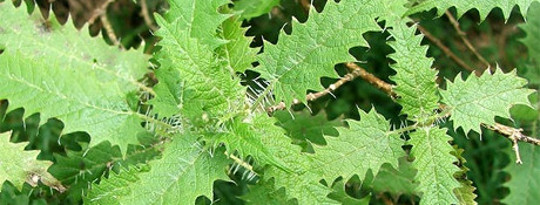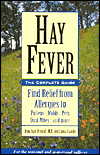
There are various herbal medicines on sale that claim to alleviate hay fever and perennial allergic rhinitis. The following ones have been tested:

Butterbur (Petasites hybridus)
Butterbur (Petasites hybridus) may be a very effective treatment for hay fever. It was recently compared to an antihistamine and did just as well in controlling hay fever symptoms, but did not produce drowsiness. This plant contains substances that are known to affect the immune system, and it has also been used to treat asthma.
 Stinging nettle (Urtica dioica)
Stinging nettle (Urtica dioica)
Stinging nettle (Urtica dioica) was thought to be as good as, or better than, previous hay fever medications by half of the patients tested. The dose used was two 300 mg capsules taken whenever symptoms were experienced. This is not a conclusive study, but it does suggest that stinging nettle might be a useful treatment. It is probably a safe herb.
 Ginkgo (Ginkgo biloba)
Ginkgo (Ginkgo biloba)
Ginkgo (Ginkgo biloba) may decrease the body's reaction to allergens. (For those with pollen asthma, it could also help by calming the inflammation of the airways.)
Get The Latest By Email
 Luffa complex (also marketed as Pollinosan)
Luffa complex (also marketed as Pollinosan)
Luffa complex (also marketed as Pollinosan) contains extracts of several different plant products, including the sponge cucumber. (Also called a luffa or loofah, this is better known as a scratchy cylinder used to scrub the skin while showering.) Unpublished results of a trial carried out by the manufacturer suggest that 75 percent of hay fever sufferers find benefit from this mixture. Needless to say, a published trial from an independent research team would be more convincing.
Grape seed extract
Grape seed extract has been tested with hay fever sufferers and showed no benefit.
Quercetin
Quercetin is found in red wine, apples, onions, and other foods and is therefore likely to be safe as long as you don't overdo the dose. It has been tested in the laboratory with mast cells taken from the noses of people with allergic rhinitis (mast cells are responsible for starting off the allergic reaction). Exposure to quercetin made the cells less likely to respond to allergen. That is impressive, but it is not known if this translates into real benefits when quercetin is swallowed by hay fever sufferers—there are all kinds of unknowns involved. When absorbed from the stomach, does it reach the nose intact? Does quercetin affect the mast cells in the same way when they are in the nose rather than in a test tube? If you want to give quercetin a try, in spite of these unknowns, the dose usually recommended is between 250 mg and 600 mg, taken 5 to 10 minutes before meals.
Perilla 6000 (contains Perilla frutescens)
Perilla 6000, which is marketed as a treatment for hay fever and other allergies, contains Perilla frutescens, a Chinese herb with a long folk tradition of treating allergy, plus Coleus forskohlii. The latter has been tested for asthma and has definite benefits, but it can also cause unpleasant side effects: soreness in the mouth and nausea. Perilla itself has been tested only in animals, but did show promising results in blocking allergic reactions. (Unfortunately, this mixture also contains alfalfa, which is harmful to some people with autoimmune diseases such as systemic lupus erythematosus.) Perilla 6000 is not yet sold in the United States, but can be ordered from suppliers in the United Kingdom or Australia, who can be found via the Internet.
Allergic Reactions to Herbal Medicines
Before taking any herbal medicine, consider the possibility of allergic reactions, particularly if you suffer symptoms in the mouth from certain foods. Proceed very cautiously (sec "Herbal Medicines" on page 167). Remember that something as apparently innocuous as chamomile could cause potentially fatal asthma attacks in a few susceptible hay fever sufferers (see the box with Jack's story on page 168).
Toxicity is also a possibility to bear in mind. The idea that something must be safe because it is "natural" is obviously mistaken--hemlock is natural and so is belladonna, both deadly poisons. Most plants are not this lethal but would still make you ill if you ate them. Why else do we warn our children, when out on rambles, not to eat leaves, berries, or fungi, other than the few that we know are safe?
The other great myth about herbal medicines is that they must be safe "because people have been using them for centuries." The fact is that side effects that are slow to appear, or affect only a minority of people, will not necessarily be traced back to their true cause. Dozens of cautionary tales can be told about substances (not just herbal medicines, but also local foodstuffs and ceremonial substances such as tobacco) that had been used for eons and seemed unimpeachable, but were actually very damaging. Their toxicity went unrecognized for centuries, even millennia, just because the bad effects were variable and didn't come on immediately.
It is also true, with substances derived from food plants, that they might be safe at the levels normally consumed but dangerous when taken at high dose in purified form. This has proved to be the case with beta carotene, a pigment and antioxidant found in carrots, apricots, mangoes, and many other fruits. When taken in high dose by smokers, it actually increased the risk of lung cancer rather than decreasing it, as was hoped.
If you are thinking about taking a particular herbal medicine, you could try writing to the manufacturer to ask if it has been tested for safety according to modern standards. Unfortunately, very few have, so you must be on the lookout for side effects when taking herbs. Notice any changes in your health, especially the signs of liver damage (yellow jaundiced skin, yellowing of the whites of the eyes, pale feces, dark urine, nausea, and pain). Deaths due to herbal medicines have generally been the result of either liver damage or kidney damage.
Herbal Interaction with Conventional Drugs
Herbal medicines can also interact with conventional drugs, in the same way that one drug can interact with another drug. The following herbs have unfavorable interactions with drugs that you may be taking for allergies:
• Kava-kava can increase the typical side effects of antihistamines: drowsiness and poor coordination.
• Ginseng, buckthorn, aloe vera, cascara sagrada, and senna all interact with steroid tablets.
• Pheasant's eye, rhubarb root, squill, and lily of the valley interact with one particular steroid: betamethasone. They will increase both the desired effects of the drug and its side effects.

This article was excerpted with permission from the book:
Hay Fever, ©1993,2002
by Dr. Jonathon Brostoff & Linda Gamlin.
Reprinted with permission of the publisher, Healing Arts Press. www.InnerTraditions.com
About the Authors
Jonathan Brostoff, M.D., is Professor Emeritus of Allergy and Environmental Health at King's College in London and an internationally recognized authority on allergies.
Linda Gamlin was trained as a biochemist and worked in research for several years before turning to scientific writing. She specializes in writing about allergic diseases, the effects of diet and the environment on health, and psychosomatic medicine. Together they have coauthored Food Allergies and Food Intolerance and Asthma.










